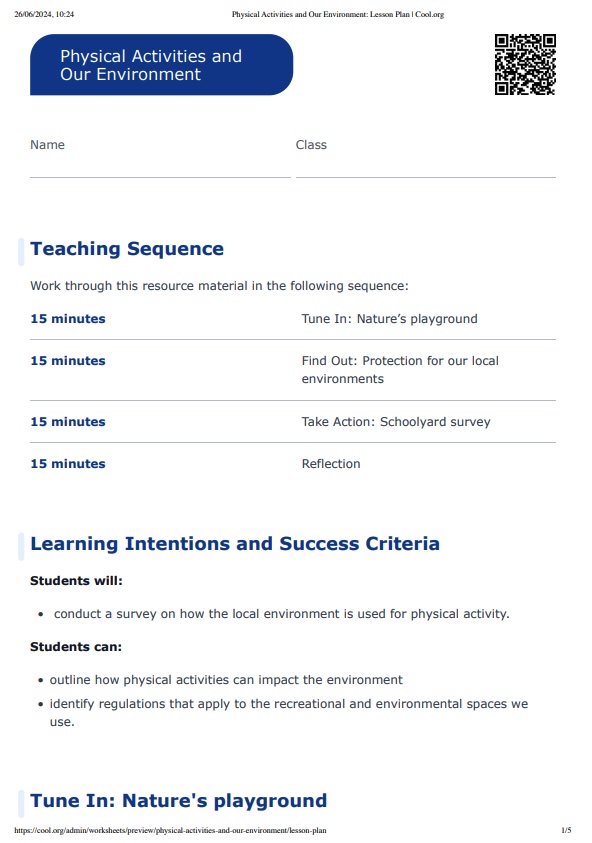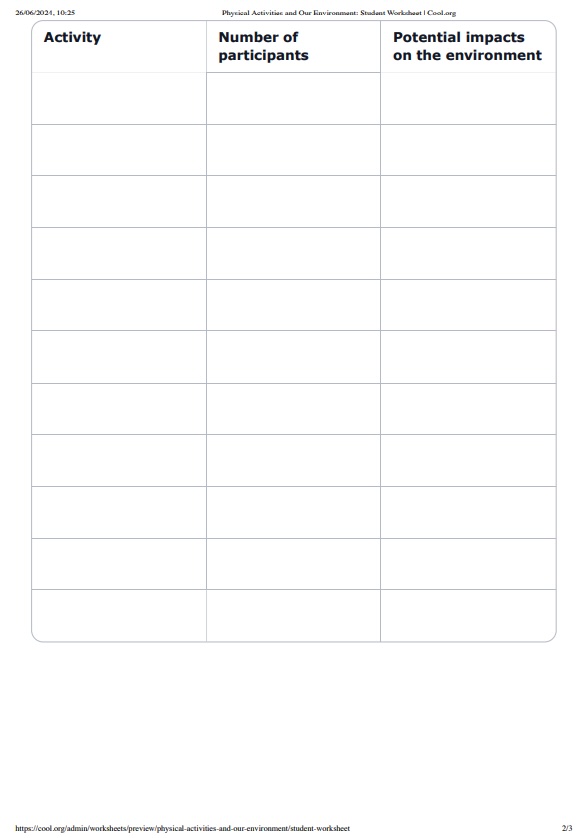Lesson summary
Students will reflect on how their physical activities can impact the environment. They will explore Victorian regulations protecting flora and fauna and assess how they can use this knowledge to protect their school environment.
Learning intentions:
Students will...
- conduct a survey on how the local environment is used for physical activity.
Success criteria:
Students can...
- outline how physical activities can impact the environment
- identify regulations that apply to the recreational and environmental spaces we use.
Lesson guides and printables
Curriculum links
Select your curriculum from the options below.
Lesson details
Skills
This lesson is designed to build students’ competencies in the following skills:
- creative thinking
- critical thinking
- communication
- community engagement
- ethical understanding
- reflection
- social skills
Curriculum Mapping
Australian Curriculum (v9.0) content description:
Year 5 and 6, Health and Physical Education
- analyse how behaviours influence the health, safety, relationships and wellbeing of individuals and communities (AC9HP6P10)
- participate in physical activities that enhance health and wellbeing in natural and outdoor settings, and analyse the steps and resources needed to promote participation (AC9HP6M05).
Relevant parts of Year 5 and 6 Health and Physical Education achievement standards: Students analyse health information to refine strategies to enhance their own and others’ health, safety, relationships and wellbeing. Students propose strategies to promote physical activity participation that enhances health, fitness and wellbeing.
NSW Syllabus outcomes:
- distinguishes contextual factors that influence health, safety, wellbeing and participation in physical activity which are controllable and uncontrollable (PD3-6).
General capabilities: Critical and Creative Thinking, Ethical Understanding, Literacy
Cross-curriculum priority: Sustainability
Level of teacher scaffolding: High - facilitate class discussions and lead students on a walk around the school grounds.
UN Sustainable Development Goals
UN SDG 15: Protect, restore and promote sustainable use of terrestrial ecosystems, sustainably manage forests, combat desertification, and halt and reverse land degradation and halt biodiversity loss
- Target 15.5: Take urgent and significant action to reduce the degradation of natural habitats, halt the loss of biodiversity and, by 2020, protect and prevent the extinction of threatened species.
Resources Required
- Student worksheet (one per student)
- Device capable of displaying audiovisual material
- Map of your school
Additional Info
This lesson has been developed in partnership with the Conservation Regulator, a government agency responsible for regulation of fire prevention, use of public land, wildlife and biodiversity. Through a combination of enforcement and education activities, the Conservation Regulator aims to maintain the health and heritage of these landscapes for future generations to enjoy.
Related Professional Learning
Using The Cool.org Act Framework in the Classroom - Primary
Quick Summary: This course will help you to empower students to take action on issues that are important to them, by offering a variety of strategies and tactics to facilitate meaningful action.





Welcome back!
Don't have an account yet?
Log in with:
Create your free Cool.org account.
Many of our resources are free, with an option to upgrade to Cool+ for premium content.
Already have an account?
Sign up with:
By signing up you accept Cool.org's Terms and Conditions(Opens in new tab) and Privacy Policy(Opens in new tab).